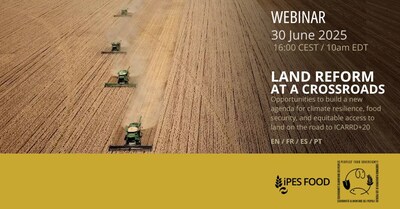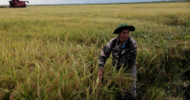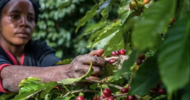Canadian Business magazine, September 14, 2009
By Jeff Sanford
A bumper crop of corn set to come in at harvest in the U.S. this year. A global recession hogging all the attention. That’s all it took, and all of a sudden the Global Food Crisis, such a topic of conversation last year, is nowhere to be seen.
The quick disappearing act has some wondering where good sense has gone. “One good year and the problem is over? That’s ridiculous,” says Donald Coxe, a well-known commodity fund manager. His latest work of art, the Coxe Commodity Strategy Fund, was the biggest IPO on the TSX last year (raising $297 million from investors). So you know where his interests lie. Nevertheless, he is concerned that we are still just one bad crop away from another round of volatile food prices. “We’ve just had the worst deflation in the postwar period, and yet the prices of food are still high,” says Coxe. “We’re still right on the edge.”
The edge he’s referring to is the amount of grain that has been carried over from the harvests of previous years. In eight out of the past nine years, the world has consumed more grain than has been produced. The net consumption has come out of existing stocks, and those stocks have been dangerously drawn down, which means we’re still flirting with a global food crisis.
The leaders who recently gathered in L’Aquila Italy for the G8 summit acknowledged this. Amid talk of food security and “farmland grabbing” (a new global scourge that sees rich countries like Saudi Arabia buying up farms in Africa to produce grain for the homeland), the leaders also released a statement that suggested that “while the prices of food commodities have decreased since their peak of 2008, they remain high in historical terms and volatile.”
But even as the world food crisis has faded from headlines, Bay Street is ramping up its reaction to the world grain shortage. Over the past few years, a couple of farmland-focused investment firms, including Agcapita Partners LP and Assiniboia Capital Corp., have been buying up western farmland. The goal: to package those holdings into securities that can be bought by retail investors as a way to hedge their investments against food, fuel and monetary inflation.
Earlier this year, Sprott Resource Corp. announced the latest of these corporate-level farmland ventures: One Earth Farms Corp., launched in March.
Sprott Resource has seeded One Earth with $27.5 million, which the founders have used to hire a management team and lease the company’s first 12,000 acres, in production this year. The company plans to lease up to 100,000 acres next year. It will then significantly increase to an eventual goal of becoming the single largest farming operation in Canada.
It’s true the current recession may see prices fall yet, over the short-term. However, according to Steve Yuzpe, the CFO of Sprott Resource, ongoing population growth, dwindling arable land, water issues, even the falling yield productivity delivered by genetically modified seeds will be the big drivers for continued record demand—pushing food prices ever higher. “We had a little taste of what’s happening last year with the riots and grain export bans. But when you put the macro pieces together, you see why we’re excited about this,” says Yuzpe.
One Earth will harvest the economic efficiencies that size will deliver (the company will have an agronomist on staff and will be able to utilize its equipment far more efficiently than any smaller farm). But the founders’ initial impulse to create the organization stems from a confluence of trends at the global level. And it’s this that has made grains such an in-demand commodity.
The latest Farm Credit Canada farmland value report suggests these new farmland plays are already generating good returns for unitholders, before they’ve even sold a bushel. The report found Canadian farmland increased in value by an average of 5.6% in just the past six months of 2008, with Saskatchewan farmland (where Agcapita is focused) up an amazing 8.8%.
A quick glance at the most recent inflation numbers from Statistics Canada confirms why this might be happening. Inflation decreased in June for the first time since 1994—but in the 12 months to this June, food prices were up 5.5%, during a recession, when the key cost in the agriculture sector—energy—was falling.
The story in the U.S. is the same. According to a recent report from Benjamin Tal of CIBC World Markets Inc., food inflation stateside is still running at a “red hot” 5%. What’s more, the gap between food inflation and core inflation is the widest seen since the food crisis of the 1970s (with the exception of 2004). That is puzzling. The trend for the past 40 years has been that food inflation leads the inflation cycle by four or five months. According to that pattern, we should have seen food prices come down before energy prices did in this cycle. But that didn’t happen. And that, says Tal, suggests there is a bigger trend at play here. “Clearly there are some structural shifts going on that are overwhelming the cyclical forces that would normally prevail over food inflation in the midst of one of the deepest postwar recessions on record.”
He’s referring to global macroeconomic shifts in how we consume. Improvements in agricultural energy intensity (the amount of energy needed to grow a given amount of crops) has fallen from 4.5% in the 1980s to 0.5% today. At the same time, there has also been a massive shift to a more western, middle-class diet in the rapidly expanding Chinese and Indian economies. Tal says that consumption of meat has risen from 27 kilograms per capita in the ’70s to 40.5 kg today. That puts a significant strain on the global grain supply, as it takes a lot of grain to produce meat. And let’s not forget new demand from the biofuel industry. According to a report released last July by the Conference Board of Canada, the 80% rise in the price of agricultural commodities from 2005–2008 was not a matter of speculation, but rather hoarding and ethanol production in the U.S., where one-third of the corn crop is going to biofuels.
Coxe says he is disappointed to see Obama, the former state senator for the grain state of Illinois, get behind that country’s ethanol program. By directing corn into the gas tanks of the nation, it directs precious supplies away from food markets, sharpening shortages and putting upward pressure on grain prices. “I’d rather pay 50¢ more for a gallon of gas than produce huge amounts of ethanol, which is ethically and morally unjustifiable,” says Coxe. But with no one stepping in the way of the ethanol train, it looks like the boom in farmland is going to be with us for some time yet.
What’s more, as Coxe indicates, there is a possibility that prices will experience further upward spikes this fall. Here in Canada, the Canadian Wheat Board reports shipments for the 2008–2009 year ending July 31 are the highest they’ve been since 1999–2000—but intensely dry weather has delayed crop development by a couple of crucial weeks this spring. At the same time, the U.S. Midwest is experiencing its third-coldest July on record, a matter of the current “global cooling” trend caused by low sunspot activity. “The jet stream is over Chicago. It should be much further north at this time of the year,” says Coxe. So while there is a record amount of corn ripening in the Midwest this summer, there is also a real danger of an early frost. That counters the notion of a bountiful crop and bears out Coxe’s concern that grain supply is still not as resilient as it needs to be. “The carryover [the amount of grain left over at the end of the growing season] is still negative. So I don’t think we should stop talking about food policy,” says Coxe. “We are still one bad crop away from trouble.”











